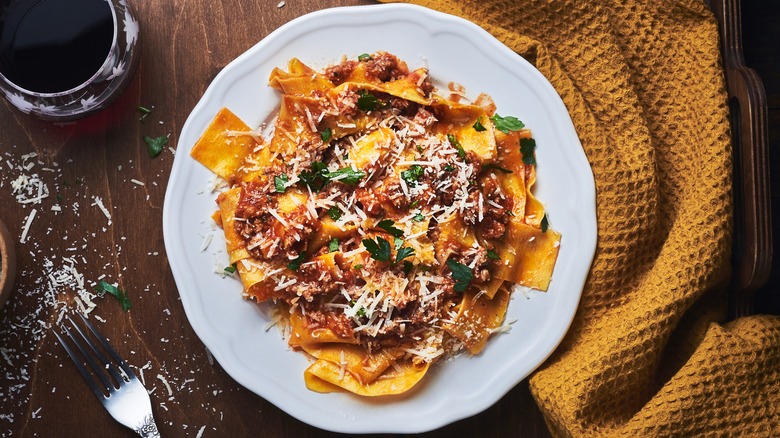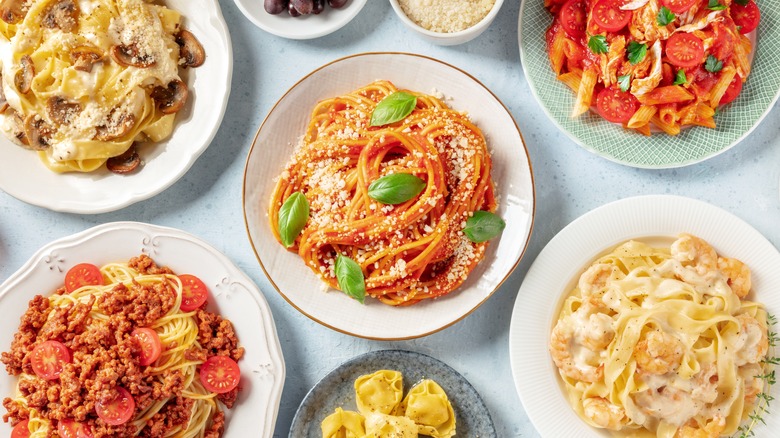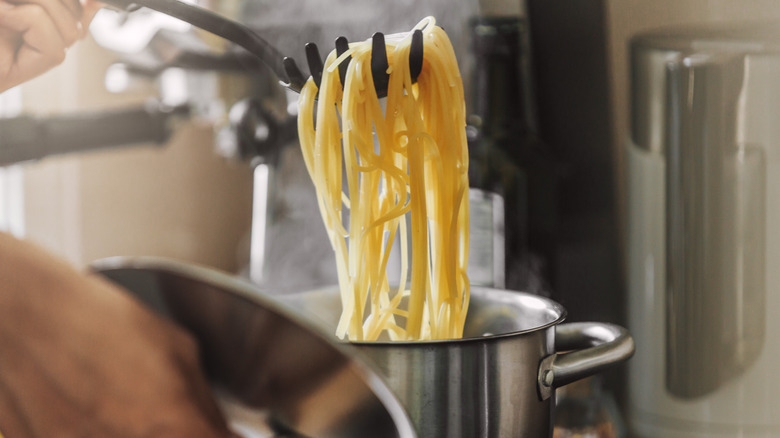How To Choose The Right Type Of Sauce For Your Pasta
One of the (many) wonderful things about pasta is that there are seemingly endless shapes and sizes to choose from — over 500, according to DeLallo. You can go with a short and small pasta like elbows or orzo, a tubular one like penne or rigatoni, something ridged or curled like Gemelli or fusilli, a long and thin noodle like linguine or capellini, or a scooped shape like orecchiette or shells. The list goes on and on, each unique shape providing its own distinctive pasta-eating experience.
But even though most types of pasta are made with basically the same ingredients — and let's be honest, every shape and size is delicious — that doesn't mean they're necessarily interchangeable. There are countless varieties of pasta out there for a reason, and different types of pasta are ideal for different types of pasta sauces.
So how do you know what kind of sauce will best complement that pasta you've got in your cabinet, whether it's bowties or bucatini? There are some guiding principles that can help you choose the right shape-and-sauce combo so your pasta dish can live up to its full potential. We'll boil it down for you.
Best sauces to pair with different pasta shapes
For long, thin pasta like capellini, spaghetti, and bucatini, you'll want to stick to a delicate sauce. Something really light like a buttery herb sauce, a simple garlic and oil sauce, a light tomato sauce, or even an oil-based seafood sauce will work well — as long as it's not rich or heavy so it doesn't weigh down the pasta. A sauce that's thin in consistency is a good choice for pasta that's thin and long because the sauce will be able to evenly coat the noodles (per Tasty) while allowing the pasta to keep its delicate shape.
Tubular shapes like rigatoni, penne, and ziti lend perfectly to a classic bolognese or other hearty sauces loaded with meat or vegetables, like a sausage, eggplant, or primavera sauce. That's because their natural shape and ridges help those chunkier sauces cling on well, almost getting trapped in the pasta so that every tube has its share of sauce.
When it comes to thicker, textured pasta with more of a unique shape to it — like fusilli, orecchiette, cavatappi, gemelli, or shells — you can go with a richer, heavier sauce because the pasta is a bit stronger and can stand up to it, DeLallo explains. These shapes are great for cream-based, cheesy, or rich tomato sauces because their curves act like little suction cups that soak up the decadent flavors. For these shapes, go with sauces like alfredo, carbonara, pesto, or a hearty marinara.
More tips for perfecting your pasta experience
The right pasta and sauce pairing are essential to a truly great pasta dish, but there are plenty of other important pasta rules to keep in mind if you want to make the most of pasta night.
A big one is to remember to first salt, and then reserve your pasta water — don't skip either step. Salting the water not only seasons the bland pasta and gives it some initial flavor while it cooks, but it also results in that salty, starchy leftover pasta water that can be the secret to any good sauce. You want to reserve some water when you remove or drain your pasta because adding some of that magical liquid to your sauce will help flavor and thicken it up for the ideal texture.
Another tip to swear by — cook your pasta al dente. That means pulling it out of the water a minute or two before it's done cooking when it still has that firm bite in the center because typically, you'll continue to prepare the pasta in a sauce or with a technique that ends up cooking the noodles a bit longer. By being vigilant about al dente timing, you can offset that extra time spent in the pan and avoid an overcooked or mushy outcome — instead ensuring a final result that's cooked to perfection.


